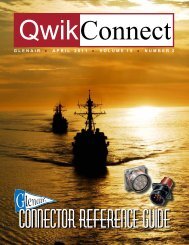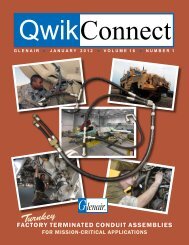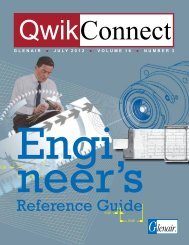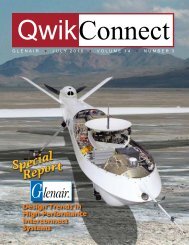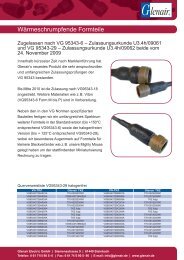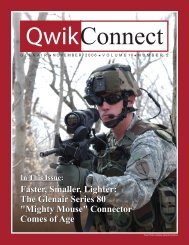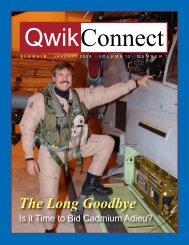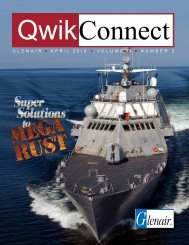July 2008 - Glenair, Inc.
July 2008 - Glenair, Inc.
July 2008 - Glenair, Inc.
Create successful ePaper yourself
Turn your PDF publications into a flip-book with our unique Google optimized e-Paper software.
British munitions<br />
manufacturers<br />
during world<br />
war II found that bombs<br />
would sometimes explode<br />
in factories during<br />
assembly, so they adopted<br />
procedures to ensure<br />
production quality and<br />
reduce the risk of mishaps.<br />
Factories were required to<br />
document manufacturing<br />
procedures and keep<br />
records as proof that<br />
procedures were being<br />
followed. These procedures<br />
were eventually compiled<br />
into what became known<br />
as British Standard 5750<br />
(BS 5750).<br />
Over forty years<br />
later in 1987, the British<br />
Government persuaded<br />
the International Organization for Standardization<br />
(ISO) to adopt BS 5750 as an international standard<br />
that became ISO 9000. Over time, revisions to<br />
ISO 9000 resulted in quality standards for design,<br />
development, installation and servicing. In-process<br />
quality requirements spurred development of<br />
preventative actions, as opposed to previous models<br />
that focused only on evaluating the final product.<br />
US defense standards such as MIL SPECS, NATO<br />
specifications and NASA standards also influenced<br />
the evolution of ISO 9000. In these early years,<br />
ISO 9000 was implemented exclusively by large<br />
companies. But by the mid-1990s, small and midsized<br />
companies began to adopt the standard.<br />
In 2000, the ISO combined all ISO 9000<br />
revisions into one new standard—ISO 9001.<br />
The 2000 version further emphasized process<br />
management and specified additional involvement<br />
by upper-level managers and executives to better<br />
10<br />
QwikConnect<br />
The Evolution of Aerospace Industry<br />
Quality Assurance Systems<br />
integrate quality into<br />
business systems and<br />
avoid delegation of quality<br />
functions solely to junior<br />
administrators.<br />
Parallel to the rise<br />
of ISO 9000 and 9001,<br />
numerous companies<br />
within the aerospace<br />
industry were establishing<br />
their own quality standards,<br />
often in isolation from one<br />
another. The resulting<br />
patchwork of competing<br />
requirements was<br />
sometimes maddening<br />
to suppliers charged with<br />
compliance, as each OEM<br />
required a dizzying array<br />
of unique documentation,<br />
auditing and reporting<br />
procedures.<br />
In 1996, SAE<br />
Aerospace Resource Document (ARD) 9000<br />
emerged from a working group of US aerospace<br />
prime contractors, including Allied-Signal, Allison<br />
Engine Company, Boeing, General Electric Aircraft<br />
Engines, Lockheed Martin. McDonnell Douglas,<br />
Northrop Grumman, Pratt whitney, Rockwell Collins,<br />
Sikorsky Aircraft, and Hamilton Sundstrand. About a<br />
year later, SAE International’s American Aerospace<br />
Quality Group (AAQG) published AS 9000:<br />
Aerospace Basic Quality System Standard.<br />
A major revision in 2000 tied the new AS 9100<br />
closely to ISO 9001, with additional requirements<br />
unique to the aerospace industry. AS 9100 has now<br />
been universally accepted by aerospace OEM’s<br />
worldwide, and the Federal Aviation Administration<br />
has recognized AS 9100 as a comprehensive quality<br />
standard that meets federal regulations, giving<br />
suppliers renewed confidence in ISO style systems.<br />
QwikConnect n <strong>July</strong> <strong>2008</strong>



